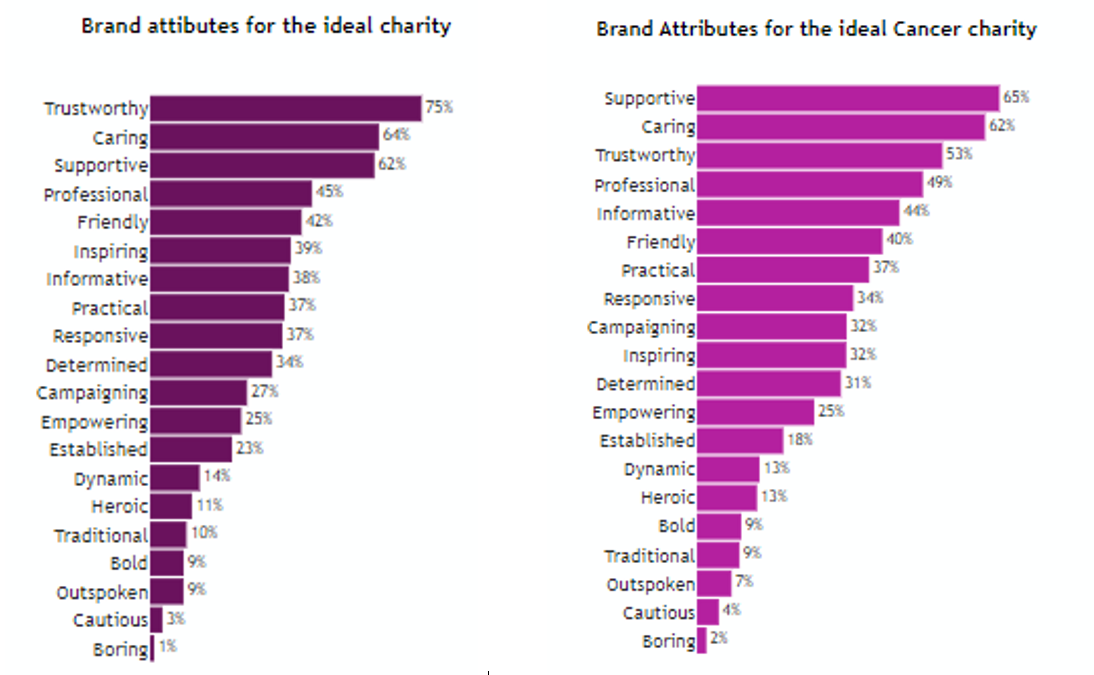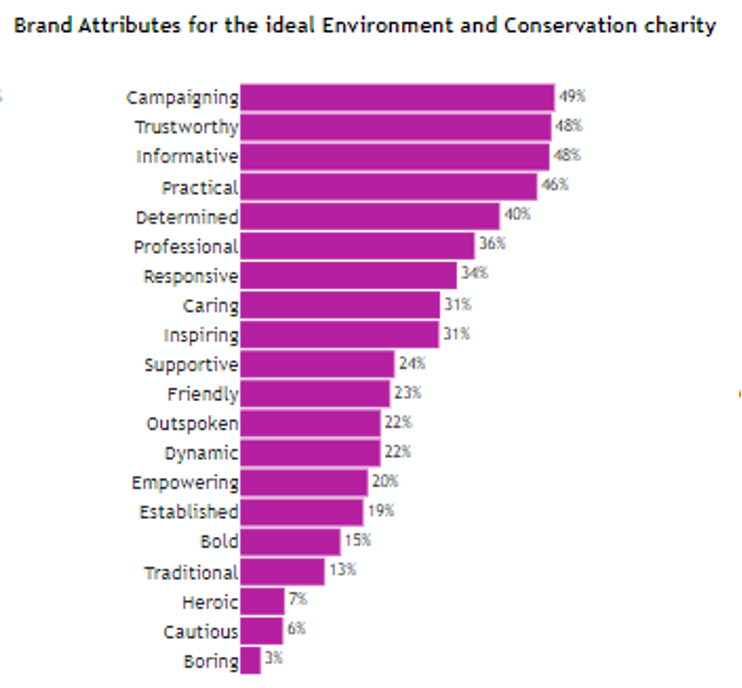Our Charity Brand Evaluator (CBE) is a biannual survey dedicated exclusively to charity brands; in CBE, we ask a range of questions about individual charity brands as well as the public’s ideal charity. You can read more about what we ask in CBE here. What follows are three interesting insights from the latest wave of CBE which ran in July 2020.
The public like cancer charities
When asked to rate on a scale of 0-10 how much they liked each brand, the respondents showed clear preference for Cancer brands. When we calculated the average of the answers and benchmarked all the forty something brands we tested in CBE, 4 out of the 5 brands that had the highest preference were Cancer charities. Our Charity Awareness Monitor has always shown that cancer is the UK’s top favourite cause, so this isn’t anything new. But CBE’s brand preference question shows some minor yet interesting differences between cancer brands. For example, take two major cancer charities (without naming names here!). Younger people aged 16-34 liked Cancer Charity A slightly better than Cancer Charity B, while for people aged 55 and over Cancer Charity B wins over Cancer Charity A. For all age groups, Breast Cancer Now and Prostate Cancer UK are very similar in terms of their brand popularity levels, but both are more popular among their target gender, women vs. men. Beyond cancer, younger age groups tend to also like brands in the Animals sector, while Armed Forces charities achieve high popularity among older age groups.
The pandemic hasn’t changed public expectations of charity
We asked members of the public to describe their ideal charity in a set of adjectives. In Autumn 2019, its top attributes were trustworthy (74%), caring (64%), and supportive (62%). Did the Covid-19 outbreak change any of these? In July this year the public described their ideal charity as trustworthy (74%), caring (64%), and supportive (62%) – the same set of attributes with identical data. Despite the unprecedented disruption the virus has caused, the public expectation of charities has remained steady: the public want charities to be warm and reliable. In turn, action-based attributes are low on the list: only 11% describe their deal charity as heroic, bold (9%), or outspoken (9%).
The same set of attributes – supportive, caring, and trustworthy (a.k.a. the holy trinity of attributes) – still reign as top attributes for the ideal Cancer charities. Looking beyond health charities, we see a slightly more diverse set of attributes. For example, while the public still want them to be supportive, caring, and trustworthy, their ideal charity working in UK poverty is also practical (47%), responsive (41%), and campaigning (35%). Action-based attributes are more valued in this sector. Similarly, the ideal youth organisation is friendly (57%) and inspiring (44%), reflecting its importance for young people, while being professional (46%) is the third most important attribute for the ideal armed forces charity. The public’s ideal Environment & Conservation charity really stands out – their top attribute is campaigning at 49%, followed by trustworthy (48%) and informative (48%). The Environment & Conservation sector can be said to be distinctly different from other sectors.
The pandemic made charities less visible
The lockdown imposed in March to close all non-essential shops and services was one of the biggest blows to charity shops and local gatherings, many of which have remained closed/not happened for over two months. One of the metrics we test in CBE is Visibility, which measures the strength of charity communication based on how often people hear, see, and talk about each charity. Across the sector, those that rely on charity shops seem to have been particularly affected, which shows the importance of high street presence and face-to-face communication for charities. For instance, while 36% of respondents answered they had conversations about a cancer charity with friends or family in October-November 2019, this dropped to 27% in July 2020. Another charity with a strong high street presence also saw 25% answering they had conversations about them before the pandemic, while only 19% did so in July 2020. On the other hand, others that didn’t rely so much on trade income maintained their levels of visibility – people kept talking about Nature & Wildlife charities to the same extent as before Covid-19.



